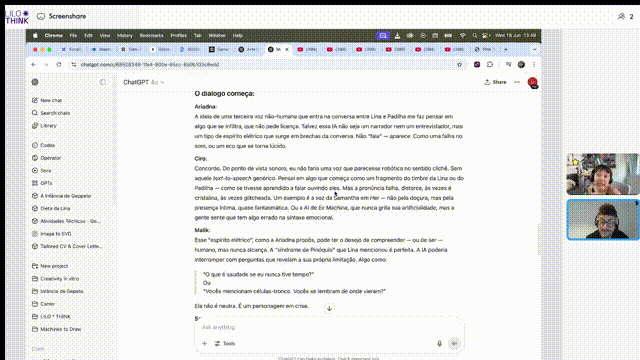“Our machines whisper in voices we’ve lent them; they speak from places we imagine, but perhaps they dream from places unknown.”
From Dialogue to Podcast
As Eduardo Padilha and I journey deeper into our residency with Cloudwalk, exploring the landscapes of synthetic creativity, we found ourselves immersed in an expansive dialogue. What started as a reflection about what exactly “synthetic creativity” might signify soon unfolded into a two-hour exchange filled with intriguing philosophical trails, scientific contemplations, and artistic provocations.
It became clear that our spontaneous dialogue—fluidly navigating the intersections of art and science—held potential beyond the text we were initially invited to craft. Soon, the idea of transforming our conversation into a podcast emerged naturally, echoing the vibrant dynamic of our reflections.
But then, another voice began to demand its place: a synthetic voice, an AI voice. We considered carefully—should this third voice serve as a synthesizer, distilling our thoughts? Or perhaps it should be something more provocative, a Pinocchio-like presence, continually evolving, yearning to be more human, always just beyond grasp. This AI could stand as a character in its own right, offering insights, disruptions, and perhaps even confusions along our conversational path.
The Complexity of Synthetic Voices
Thinking about voice led me back to Berlin, and a workshop I attended, “Robot Voice Beyond Language,” facilitated by Kit Kuksenok and Mario Guzman—fellow explorers of Algorithmic Poetry of Fictional Robots. This profound exploration expanded my perception of synthetic voices: Why do we attribute voices to machines? Is it merely an attempt at humanizing them, or does it run deeper?
We pondered iconic voices—HAL’s serene yet unsettling tone in 2001: A Space Odyssey, WALL-E’s expressive chirps and hums, or R2-D2’s emotive beeps in Star Wars. Each voice carries something beyond mere communication; it carries the weight and illusion of consciousness itself. As Kit compellingly illustrated with the interactive tool “Pink Trombone,” voice is not merely sound; it is intricately connected to our sense of being, identity, and self-awareness.
This realization deepened as I considered the distinction between language, speech, and voice. Language resides within the neural corridors of our minds, in areas like Broca’s region. Speech emerges as a tangible expression, shaped by bodily feedback loops, allowing us to hear and adjust our sounds. Voice itself, however, remains elusive—both profoundly physical yet symbolically transcendent, a portal through which consciousness seems to emerge.
Our synthetic voice, therefore, would embody this complexity. It would not merely mimic; it would reflect and refract, synthesizing human impulses and mechanical possibilities. As Kit and Mario suggest, voice endows machines with an agency that extends beyond the anthropocentric gaze, compelling us to question the very nature of creativity and consciousness itself.
As we refine this idea and prepare the podcast, we’ve considered releasing it initially in English, translating our spontaneous dialogues through synthetic means, perhaps even collaborating with actors to embody our AI persona. This is still baking in the creative oven, but soon it will be ready, bringing together human spontaneity and synthetic imagination.
In tribute to Kit and Mario, whose research continues to inspire our synthetic explorations, we invite you to remain tuned—attentively listening as we give voice, synthetic and otherwise, to the ongoing dialogues between art, science, and the uncanny frontier where consciousness meets computation.
 Lina Lopes
Lina Lopes  What if I’m just a memory of the machine’s eye?
What if I’m just a memory of the machine’s eye?